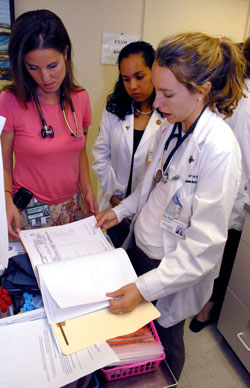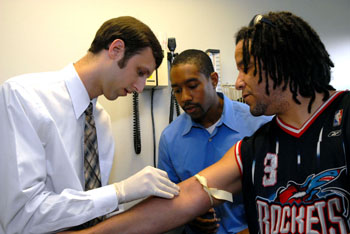
Beth Ann Sastre, M.D., left, and Vanderbilt medical students Ravneet Kaur Nagi, center, and Eve Henry look over charts at the Shade Tree Clinic. (photo by Susan Urmy)
Student-run Shade Tree Clinic expanding services

VUSM students Brett Donegan, left, and John Pitts work with patient Harry Western at the Shade Tree Clinic. (photo by Susan Urmy)
Vanderbilt University School of Medicine students have received grants to improve dental care and diabetes management at the Shade Tree Family Clinic.
Run by Vanderbilt medical students, the free clinic provides care to the uninsured and underserved population in the East Nashville area near Dickerson Pike.
The Alpha Omega Alpha (AOA) Honor Medical Society will provide support in establishing a Dental Partnership Project. Beginning in 2009, basic dental care will be provided on-site at Shade Tree. The clinic will also provide financially supported referrals to the Meharry Medical College Dental Student Clinic and to community dentists.
“I think we are taking a big step toward making a real difference in the access and affordability of dental services for our patients,” said Meredith Albin, one of the clinic's student directors.
The clinic has made plans to dedicate a room for dental treatment in the near future.
The Association of American Medical Colleges (AAMC) will bolster diabetes management in the clinic through their Caring for Community Grant Program, which is directed toward treating, educating and supporting uninsured patients in managing their diabetes.
“Uninsured and underinsured patients with diabetes are often unable to access the medications and health specialists they require, and as a result, the quality of their diabetes care can be significantly lowered,” said Alon Peltz, student director of Shade Tree. “This grant from the AAMC will allow our clinic to provide the medical support, diabetes medications and testing equipment our patients need.”
The Boulevard Bolt, one of the largest 5-mile races in the country, has also supported the clinic. It has given Shade Tree $7,500 for the treatment of hypertension, diabetes and obesity.
These grants would not have been possible without the efforts of VUSM's students. Rebecca Cook, is the student representative for the Dental Partnership Project. Albin and Peltz guided the proposal for the Caring for Community Grant and oversee the student activities of the clinic, which operates on Tuesday and Saturday evenings.
“It's a huge time commitment. Many of these students will be in the clinic the night before exams,” said Robert Miller, M.D., the clinic's medical director. “During the year, you will see students in the hallways at Vanderbilt, fielding phone calls concerning patients they saw in the clinic the night before.”
During their first and second years, nearly all of Vanderbilt's medical students spend time in the clinic. This provides clinical exposure during years that are traditionally set aside for learning the basic sciences. Students who volunteer during their third and fourth year gain valuable teaching experience as they guide lower classmen. Attending physicians from Vanderbilt Medical Center work at the clinic on a volunteer basis, providing essential experience and guidance for the students.
The clinic has grown tremendously since it opened in September 2005, and the doctors and students there are beginning to see an unexpected diversity in disease pathology.
“We expected, when we started the clinic, to provide basic care, treating things like earaches and sore throats. But now we are seeing serious disease,” said Miller.
In response to this growing diversity, Shade Tree is expanding its services. Most recently, they have added psychiatric care and social services.
For Albin, Shade Tree has helped her focus on personal growth as well as on her rigorous coursework.
“It's helped me to remember that it's not all about the textbooks and facts; there's a human side of medicine as well, and many things that you cannot learn solely in a classroom,” she said.













